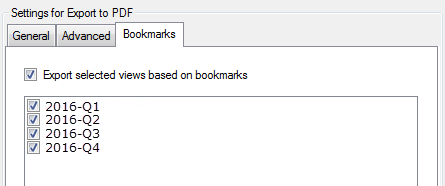| Destination Path
|
Specify the location (on the computer running
Spotfire Automation Services) and file name of the exported PDF file.
Note: The file will be saved to the node executing the job. Therefore you must make sure that the folder you select as destination folder actually exists on that computer, and that you have writing permissions on the selected folder.
Note: Allowed file paths may be limited by the
allowedFilePaths setting in the
Spotfire.Dxp.Worker.Automation.config file. For more information, see the
Spotfire Server and Environment Installation and Administration help.
|
| Export what
|
Define which parts of the analysis to export. For more information about what the options in this drop-down list mean for the different export types, see the following topics in the
Spotfire Analyst help: "Exporting to PDF" and "Exporting Bookmarks to PDF".
Note: If you export bookmarks, then the PDF file will contain one set of PDF pages for each bookmark. For example, if you export three bookmarks and select
All pages, then you will get a PDF document containing all the pages in the analysis times three (that is, one set of all analysis pages for each of the bookmarks). The descriptions of the drop-down list options below are based on regular export where each page or visualization appears only once in the resulting PDF.
|
| Active visualization
|
Exports the active visualization in the analysis (or in the bookmark, for bookmark export) to a single page in a PDF document.
Note: Tables and trellised visualizations may be extended to more than one page.
|
| Active page
|
Exports all the visualizations on the active page in the analysis (or in the bookmark, for bookmark export) to a single page in a PDF document.
|
| Active page (new page for each visualization)
|
Exports all the visualizations on the active page in the analysis (or in the bookmark, for bookmark export) to one or more pages in a PDF document. Each visualization on the active page will be exported to a new page in the PDF document.
Note: Tables and trellised visualizations may be extended to more than one page.
|
| All pages
|
Exports all the visualizations on all the pages in the analysis. Each page will be exported to a new page in the PDF document.
|
| All pages (new page for each visualization)
|
Exports all the visualizations on all the pages in the analysis. Each visualization in the analysis will be exported to a new page in the PDF document.
Note: Tables and trellised visualizations may be extended to more than one page.
|
| Details-on-Demand
|
Exports the Details-on-Demand to one or more pages in a PDF document. Select the check box
Trellis panels and table rows not visible on screen if you want to export all the data in Details-on-Demand, including data that is not visible.
|
| Use entire page
|
When exporting to PDF from Automation Services, this option is not applicable because the exported parts of the analysis do not have any proportions when the user interface is not available. Therefore, the result will always be that the exported parts of the analysis are redrawn to fill the entire space of the selected page layout.
|
| Include
|
|
| Visualization title
|
Indicate whether you want the page titles to be included in the export.
|
| Description
|
Indicate whether you want hidden visualization descriptions to be included in the export. The description will only be visible for visualizations where a description has been entered. If the description is visible in the visualization or legend, it will automatically be included in the export as a part of the visualization.
Note: A long description may be cut off when you export to PDF.
|
| Filter settings
|
Indicate whether you want the filter settings to be included in the export as textual information. Only the values of the modified filters will be listed.
|
| Page title
|
Indicate whether you want the page titles to be included in the export.
|
| Trellis panels and table rows not visible on screen
|
Indicate whether to include non-visible data in trellis panels and tables in the export. If a table contains too many rows to fit on one page in the PDF document, it will be extended to the following pages. Similarly, a trellised visualization with many panels will be extended to the following pages.
Note: Not available if you select to export
Active page or
All pages. You must select an option where each visualization is exported to a new page.
|
| Page layout
|
Define the size and orientation of the pages in the resulting PDF document.
|
| Margins
|
Define the margins of the page, in pixels.
|



